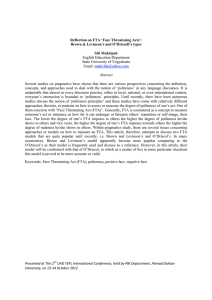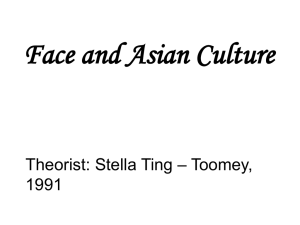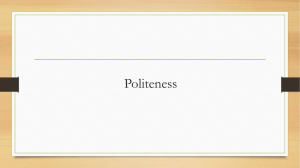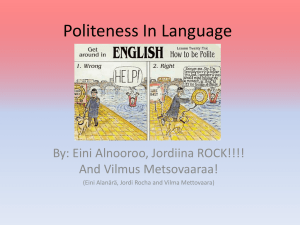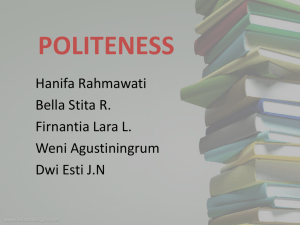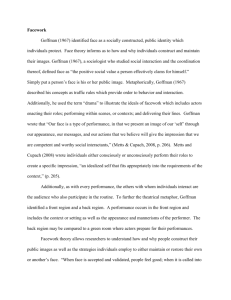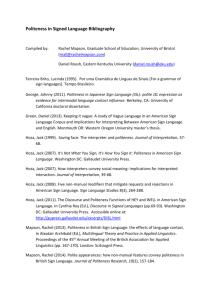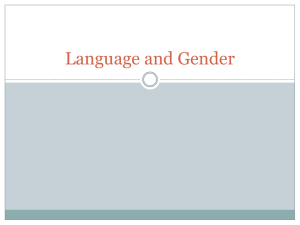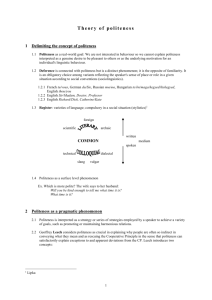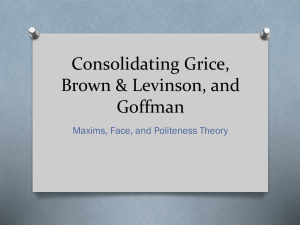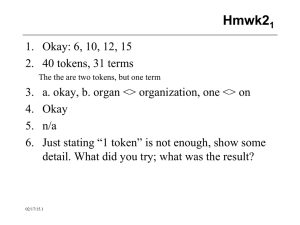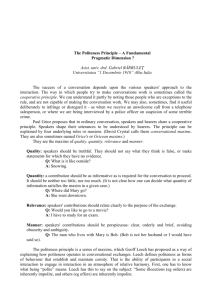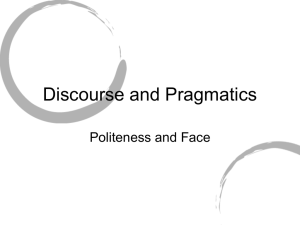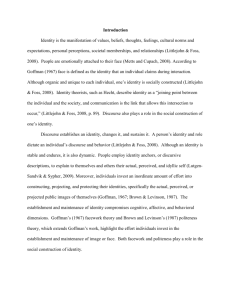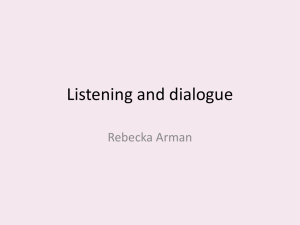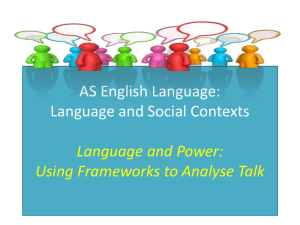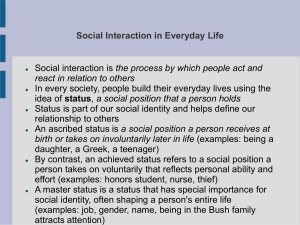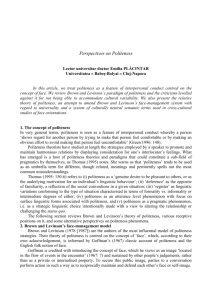Lesson 7 Politness and Face theory
advertisement
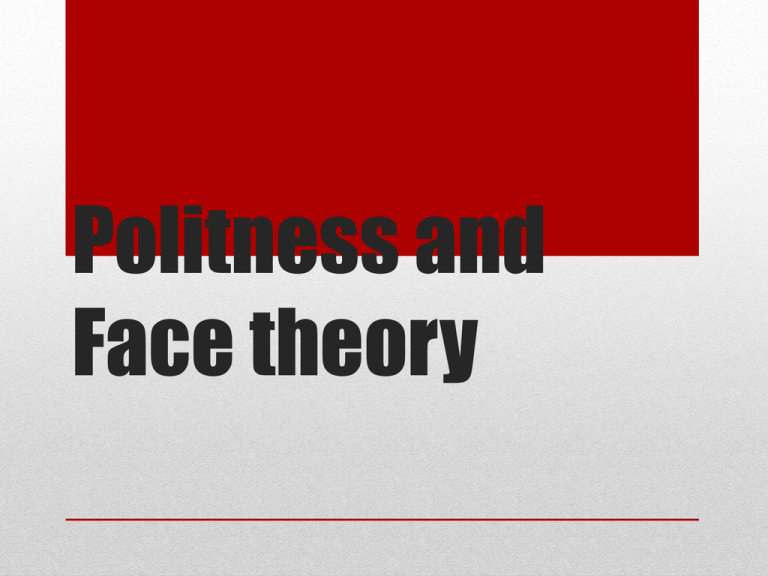
Politness and Face theory • There’s more to co-operation than following the maxims, we also need to be polite • “Co-operation is vital to conversation, but without politeness, all is lost.” Co-operation • Erving Goffman was intrigued by what lay behind everyday expressions such as ‘losing face’, ‘saving face’ and ‘being shamefaced.’ • Face is the positive social value a person effectively claims for himself by the line others assume he has taken during a personal contact.’ Goffman’s Face Face = the image that we present of ourselves to others. Irving Goffman. 1955 Goffman – Face Theory • Goffman says our face is like a persona which we present in a conversation. It changes from situation to situation. • For example, in one situation you might want to present the face of a good friend, whilst in another you may want to appear to be a knowledgeable student. •Face is maintained by the audience, not by the speaker. This is achieved by the listener accepting the face being presented by the speaker, and just generally being sensitive towards them. Examples of how this politeness is shown include: • Using appropriate forms of address •Speaking to others in a way that is appropriate to the social relationship you have with them • Speaking with a degree of formality appropriate on the occasion • Understanding the conventions of language associated with particular situations (e.g. accepting or refusing an invitation, beginning and ending a conversation) • Understanding the conventions of turn taking. Brown and Levinson Politeness. 1987 They developed Goffman’s theory of “face” into a theory of politeness: ‘positive and negative face’ •Having regard for another person’s “face” or image is an important aspect of politeness. •Brown and Levinson said that we meet the needs of “face” through positive and negative politeness. • Language or actions that reject the face someone presents to us e.g. “you don’t know how to manage this shop.” Turning your back on someone speaking to you. This clearly has implications in terms of power and status in conversation. Also face threatening acts are making impositions on people e.g. Making requests or giving orders. Although this type of face threatening act cannot be avoided, people try to mitigate the impact by speaking in an indirect way. Face Threatening Acts (FTA) • Negative Face – the desire to feel unimpeded, i.e. the freedom from feeling imposed upon by the interaction. • Positive Face – the desire to feel approved of, i.e. to maintain a positive and consistent self-image during the interaction. Positive / Negative face Positive politeness This is when you show people that they are liked, admired or included. •Paying them compliments eg. “what a lovely dress” •Taking an interest in their wellbeing eg “how are you?” •Making it obvious you enjoy their company eg “this is nice” •Making gestures of friendship •Paying attention to the other speaker (show interest, sympathy, approval) •Seeking agreement and common ground(often by choosing safe topics) •Avoiding disagreement (pretend to agree, tell white-lies) •Making jokes •using friendly/inclusive language (making assumptions - "alright if I just...") •using colloquial language showing you're on an equal footing. Negative Politeness This is when you show that you are avoiding intruding on the other person’s life, are not imposing your presence or prying into their personal affairs or to (seem to) offer a choice. Language that is indirect, apologetic and respectful. •Saying “excuse me” before asking for something •Being pessimistic e.g. “I know this is a stupid idea….” •Giving deference e.g. “yes Sir” •Being apologetic e.g. “sorry to bother you, but…” •Being indirect e.g. “I don’t seem to have a pen with me” •Offering a choice e.g. “could you…” Positive politeness used between people in a hierarchy can be used to reduce social distance. e.g. a manager suggesting to a subordinate that they use their first name: ‘Call me Sue’- a gesture of friendship. Makes the employee feel more on an equal footing. • Brown and Levinson have found we tend to use negative politeness more than positive, partially because that's our cultural bias in the UK, and partially because negative politeness is just more polite than positive politeness. • ‘Close your mouth when you eat, you fat swine.” FTA • ‘You have such beautiful teeth. I wish I didn’t see them when you eat.’ FTA using Positive politeness • ‘I know you’re pretty hungry and that steak is a bit tough, but I would appreciate it if you would chew with your mouth closed.’ • ‘I wonder how far a person’s lips can stretch yet remain closed when eating?’ What’s going on here? FTA using negative politeness Indirect FTA negative “Sorry to have bothered you with all this information – but you’re all so clever and good-looking I’m sure positive you’ll have no trouble using it…” Spot the negative and positive politeness!! • Now we’ll analyse transcript 5 together, looking for politeness strategies as well as co-operation ( maxims.) Task


